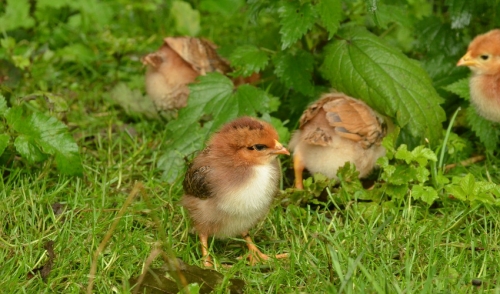{article.name}
Stay Informed
Preparing for Chicks: Setting Up Your Brooder

- Share this:
- Share on Facebook
- Pin on Pinterest
- Tweet on Twitter
Spring is chick season. Whether you are just starting a flock, increasing the numbers of chickens you keep or bringing new breeds home to try. Your brooder is critical to give for your chicks security, warmth and shelter they need for their earliest days. How can you set up a brooder to give your chicks the safest, healthiest start?
Containers for Brooders
A brooder is simply a small home for your chicks to help meet their needs and keep them safely contained as they grow. Cardboard boxes are often used as brooders, and while a large, sturdy box can be adequate, it is difficult to keep clean and can disintegrate quickly, especially if you have a larger number of chicks.
Ideally, your brooder ought to provide approximately one square foot of space per chick, and should be at least 12-15 inches high so they cannot escape easily. Taller, more spacious brooders are often preferred because they can be used longer as the birds grow larger, but the exact brooder size you select will depend on the number of chicks and breeds you choose. Different containers that can be brooders include…
- Large plastic tubs (without lids)
- Kiddie pools or paddling pools
- Galvanized metal tubs
- Wooden packing crates
- Fish tanks or aquariums
No matter which brooder you choose, make sure it is cleaned and sterilized, and repair any cracks or broken edges that could be sharp and hurt curious chicks.
What Your Brooder Needs
A safe, effective brooder is more than just a container to hold your chicks. To take proper care of your chicks, your brooder will need…
- Bedding
Chicks need a safe surface to walk on. Many different types of bedding are suitable, including pine chips, clean sand, paper towel, shredded newspaper and burlap. Avoid cedar chips or other aromatic wood chips, as they can be toxic to chicks. Also, do not use whole sheets of newspaper, as they are not absorbent and can cause leg and foot deformities in growing chicks. Sheets of newspaper can be placed on the bottom of the brooder, however, if there is 1-2 inches of bedding layered on top of the paper.
- Heat Source
Without a mother hen to snuggle under, young chicks need extra heat to keep warm. Choose a higher voltage lamp or electric heating panel that will supply sufficient heat, and position it above one side of the brooder, leaving an unheated area for chicks to retreat as they warm up. Heating sources with adjustable heights are ideal, as they can be moved as chicks grow taller. Be sure the heat source is safely positioned, however, so it is not a fire hazard either to the bedding or the side of the brooder.
- Waterer
Young chicks need a fresh, clean supply of water. A waterer or water dish should not be very deep or else chicks may accidentally drown in the basin. If the basin is deeper, adding a layer of pebbles to the bottom will keep it shallow enough to be safe and will also weight the dish down so it does not easily move or tip. Clean the waterer daily so the water remains fresh and clean.
- Feeder
Young chicks are hungry and need to eat a nutritious diet to grow properly, and your brooder will need a good feeder for those mealtimes. Ideally, use a feeder with a divided trough that will keep the chicks from running through the food or kicking it out into the bedding. If the lip of the feeder is raised slightly, chicks will be less likely to walk through the food and potentially contaminate it with shed feathers, dirt or feces.
- Thermometer
Use a good quality thermometer to monitor the brooder's temperature. As chicks grow, they will need less supplemental heat, and keeping the temperature in a good, consistent range will keep the birds warm without overheating or becoming chilled. Check the thermometer regularly throughout the day, especially if the brooder may get extra heat from the sun or chilled from nearby breezes, and adjust your heating if needed.
- Partitions
A very large brooder can be useful for larger chicks and juvenile birds, but it may be too big to be snug and comfortable for very young chicks. Solve this problem by adding moveable partitions to cut down on the area that is available to young chicks, and adjust the partitions as the birds grow to provide the proper amount of space to meet their evolving needs.
- Perches
As chicks get older, they will instinctively look for perches. Providing a few perches for the young birds will help them sharpen their perching skills and may minimize the risk of escapees as they attempt to perch on the lip of the brooder. Wooden broomstick handles, thin branches, dowels or similar materials can all make good perches, and should be positioned 2-5 inches above the bedding for birds to use.
- Cover
A very tall brooder won't necessarily need a cover, as the birds may be mature enough to be moved into their permanent coop before they learn to escape. Young chickens and even small chicks, however, can be adept fliers and may easily flutter out of shorter brooders. A screen cover will provide good air circulation to keep the birds comfortable while preventing any escape attempts. Covers will also keep inquisitive pets or marauding predators away from the vulnerable young chicks.
Once you have your brooder in place and properly prepared, it's time to introduce your chicks to their new home.
Special Offers
We are constantly adding new specials to our site. Be sure to check back often!

Comments